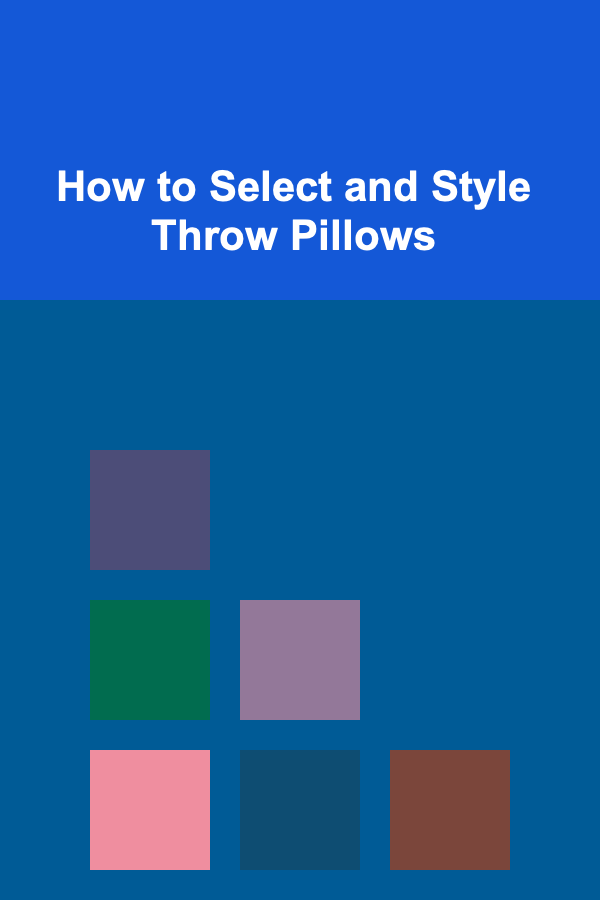
How to Select and Style Throw Pillows
ebook include PDF & Audio bundle (Micro Guide)
$12.99$6.99
Limited Time Offer! Order within the next:

Throw pillows are often seen as a simple home decor accessory, but in reality, they have the potential to transform a room. Whether you're looking to add comfort, color, texture, or visual interest to your space, the right throw pillows can make all the difference. With an array of styles, sizes, and fabrics to choose from, selecting and styling throw pillows requires thoughtfulness and attention to detail.
This article will guide you through the process of choosing and arranging throw pillows for various types of spaces, considering everything from fabric types to color coordination, and offering styling tips to elevate your living space.
Understanding the Importance of Throw Pillows
Aesthetic Enhancement
Throw pillows have the ability to instantly elevate the aesthetic of any room. Their colors, textures, and patterns add layers of visual interest to the space, complementing furniture and other elements. For example, a bold, patterned pillow can serve as the focal point of a neutral room, while soft, muted pillows can help create a serene, calming environment.
Comfort and Functionality
Beyond their decorative role, throw pillows are also about comfort. Whether placed on a couch, chair, or bed, they provide extra support and coziness. Pillows offer a sense of softness and relaxation that can make a space feel more inviting.
Versatility and Changeability
One of the most appealing features of throw pillows is their versatility. Unlike larger furniture pieces that are more difficult to replace or change, throw pillows are relatively inexpensive and easy to swap out. This allows you to update the look of your space with minimal effort and cost, whether you want to switch out seasonal colors or experiment with new textures and patterns.
Key Factors to Consider When Selecting Throw Pillows
1. Size and Shape
Throw pillows come in a variety of sizes and shapes, each suited for different functions and aesthetics. The size of your pillow should complement the furniture it's placed on, balancing the proportions of the couch, chair, or bed.
- Square Pillows: Square pillows are the most common type. They typically range in size from 16 inches to 24 inches and work well in most settings. For couches, a mix of large (22 inches to 24 inches) and small (16 inches) square pillows creates a balanced look.
- Lumbar Pillows: Lumbar pillows are rectangular pillows that provide support for your lower back or can be used as a decorative accent. They work particularly well on beds and couches, adding a touch of elegance and comfort.
- Round or Cylindrical Pillows: These pillows are more unusual in shape and can add a playful or unique touch to your furniture. They are ideal for small spaces or accent pieces.
2. Fabric and Texture
The material of your throw pillows plays a significant role in their comfort, appearance, and overall vibe. The texture of a pillow can either complement or contrast with the furniture it sits on, adding an element of visual and tactile variety.
- Cotton and Linen: Both cotton and linen are breathable, durable, and easy to care for, making them perfect for casual, comfortable settings. These fabrics work well in more relaxed spaces, such as living rooms or sunrooms.
- Velvet and Silk: Velvet and silk are luxurious, rich fabrics that elevate the look and feel of a room. If you're designing a formal space or seeking something elegant, these materials are ideal. Keep in mind, however, that they may require more maintenance than cotton or linen.
- Wool and Tweed: Wool is warm, cozy, and perfect for colder climates or fall and winter months. Tweed, a woolen fabric, adds a more textured, earthy feel and works well in rustic or traditional interiors.
- Knit and Fleece: Knit and fleece throw pillows add a cozy, comforting feel, especially in casual or cozy spaces like bedrooms and family rooms. They are often softer and can enhance the warmth and comfort of a space.
3. Color and Pattern
When selecting throw pillows, color and pattern are key elements that can make or break the design of your space. While choosing the right color is subjective and based on personal taste, there are a few guidelines that can help you strike the right balance.
- Neutral Tones: Neutral throw pillows such as beige, gray, and white are versatile and work well with almost any color palette. They offer understated elegance and can help balance bolder design elements in a room.
- Bold Colors: If you want to create a striking contrast, opt for throw pillows in bold, saturated colors like navy blue, emerald green, or mustard yellow. These can serve as focal points in a room, drawing attention and creating an exciting visual contrast with the surrounding decor.
- Patterns and Prints: Patterns such as stripes, florals, geometric designs, and animal prints add personality and interest to a space. Be mindful of how many different patterns you introduce into a room to avoid overwhelming the eye. A rule of thumb is to combine no more than three patterns in one space, and balance them with solid-colored pillows.
- Mixing Colors and Patterns: If you're daring enough to mix colors and patterns, make sure there is some consistency in your choices. For instance, pairing a solid pillow with patterned pillows that share a similar color palette can create cohesion while still offering visual contrast.
4. Functionality and Durability
When selecting throw pillows, consider the level of usage the space will experience. In high-traffic areas, such as living rooms with children and pets, choose pillows made from durable and easy-to-clean fabrics like cotton, linen, or polyester blends. These materials can withstand regular washing and use.
Additionally, make sure that the pillow filling is of high quality, as this will affect the overall comfort and longevity of the pillow. Down feathers are luxurious and soft, but synthetic fillings such as microfiber or memory foam are also excellent choices for durability and ease of maintenance.
Styling Throw Pillows: Tips and Tricks
1. Layering and Grouping
When styling throw pillows, layering them creates depth and interest. Start by placing larger pillows at the back and layering smaller ones in front. This arrangement creates a visually appealing, organized look. A typical styling method involves:
- Three Rows: For a couch, use three rows of pillows: a row of large pillows at the back, medium-sized pillows in the middle, and small pillows in the front.
- Odd Numbers: An odd number of pillows often works best, as it's more visually balanced. Use anywhere from three to five pillows for smaller seating, or seven to nine for larger furniture pieces.
2. Symmetry vs. Asymmetry
Symmetry and asymmetry are two fundamental styling techniques when it comes to throw pillows. Depending on the atmosphere you're aiming for, you can either keep things balanced or opt for an intentionally mismatched look.
- Symmetry: A symmetrical arrangement gives a sense of order and balance. For example, place two identical pillows on each side of the couch. This look is classic and works well in more traditional or formal settings.
- Asymmetry: Asymmetry adds a more relaxed and dynamic feel to the space. Arrange throw pillows in different sizes and patterns to create an interesting and more informal design. Asymmetry is often used in modern, eclectic, or bohemian styles.
3. Seasonal Styling
One of the easiest ways to refresh a room is by changing throw pillows with the seasons. For spring and summer, light fabrics such as linen or cotton in pastel or bright colors work well. During fall and winter, consider switching to richer textures like velvet, wool, or tweed, and use deeper colors like burgundy, forest green, and navy.
Additionally, during the holiday season, you can incorporate festive throw pillows with prints like snowflakes, Christmas trees, or even metallic finishes to add a bit of holiday cheer to your home.
4. Mixing Textures
To keep your design from feeling flat, mix different textures in your throw pillows. Combining soft fabrics like velvet with coarser materials like linen or chunky knit can add tactile richness to your space. Don't be afraid to experiment with contrasts---silk and cotton, for example, create an intriguing combination that feels luxurious and laid-back at the same time.
5. Play With Shapes and Sizes
While square pillows are the most common, experimenting with different shapes can create a playful or sophisticated vibe. Round or cylindrical pillows, for example, add a sense of whimsy to a space, while long lumbar pillows add elegance and support. By using varying sizes and shapes, you can create a more dynamic and personalized arrangement.
Conclusion
Selecting and styling throw pillows is an art form that requires an eye for design and an understanding of your space's needs. By considering factors like size, shape, fabric, color, and functionality, you can make thoughtful choices that enhance the aesthetic and comfort of your home. Additionally, by experimenting with different arrangements, textures, and seasonal changes, you can refresh your space and keep it looking stylish year-round.
Ultimately, throw pillows are not just about decoration---they are about making your home feel more comfortable, inviting, and uniquely yours.

10 Best Tips for Successful Discount Shopping
Read More
How to Create a Simple Yet Effective Home Storage System for Paperwork
Read More
How to Designate a Space for Unused or Extra Supplies
Read More
How to Use Under-Bed Storage to Maximize Space
Read More
How to Maintain Your Road Bike Chain
Read More
10 Tips for Using Spreadsheets to Track Life Insurance Costs
Read MoreOther Products

10 Best Tips for Successful Discount Shopping
Read More
How to Create a Simple Yet Effective Home Storage System for Paperwork
Read More
How to Designate a Space for Unused or Extra Supplies
Read More
How to Use Under-Bed Storage to Maximize Space
Read More
How to Maintain Your Road Bike Chain
Read More